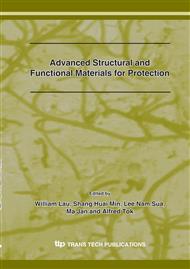p.115
p.125
p.133
p.139
p.145
p.153
p.161
p.175
p.191
Surface Roughness and Morphology Analysis Using an Atomic Force Microscopy of Polycrystalline Diamond Coated Si3N4 Deposited by Microwave Plasma Assisted Chemical Vapor Deposition
Abstract:
Diamond is the hardest material and has high chemical resistant which is one form of carbon. In the present work a study was carried out on polycrystalline diamond coated Si3N4 substrate. The diamond was deposited by Microwave Plasma Assisted Chemical Vapor Deposition (MPACVD) under varying deposition parameters namely CH4 diluted in H2, microwave power and chamber pressure. SEM and AFM are used to investigate the surface morphology and surface roughness. Nucleation phenomena and crystal width were also studied using AFM. Based on SEM investigation it was found that the chamber pressure and %CH4 have more significant effects on nucleation and facet of polycrystalline diamond, In addition microwave power has an effect on the diamond facet that changed from cubic to cauliflower structure. Surface roughness results show that increasing the %CH4 has decreased surface roughness 334.83 to 269.99 nm at 1 to 3% CH4, respectively. Increasing microwave power leads to increase in diamond nucleation and coalescence which lead to less surface roughness. Increasing gas pressure may eliminate Si contamination however it reduces diamond nucleation.
Info:
Periodical:
Pages:
153-160
Citation:
Online since:
February 2008
Authors:
Price:
Сopyright:
© 2008 Trans Tech Publications Ltd. All Rights Reserved
Share:
Citation:


